
AI workflow orchestration ensures your tools, data, and processes work together efficiently. It simplifies tasks like data preparation, model training, and deployment, while tackling challenges like fragmented data, scalability, and compliance. Choosing the right platform can save costs, improve productivity, and ensure governance. Here's a quick summary of the top platforms:
Key Takeaways:
For enterprises, platforms like Prompts.ai offer unified tools with robust security and cost transparency, while open-source solutions like Apache Airflow are ideal for technically skilled teams seeking flexibility.
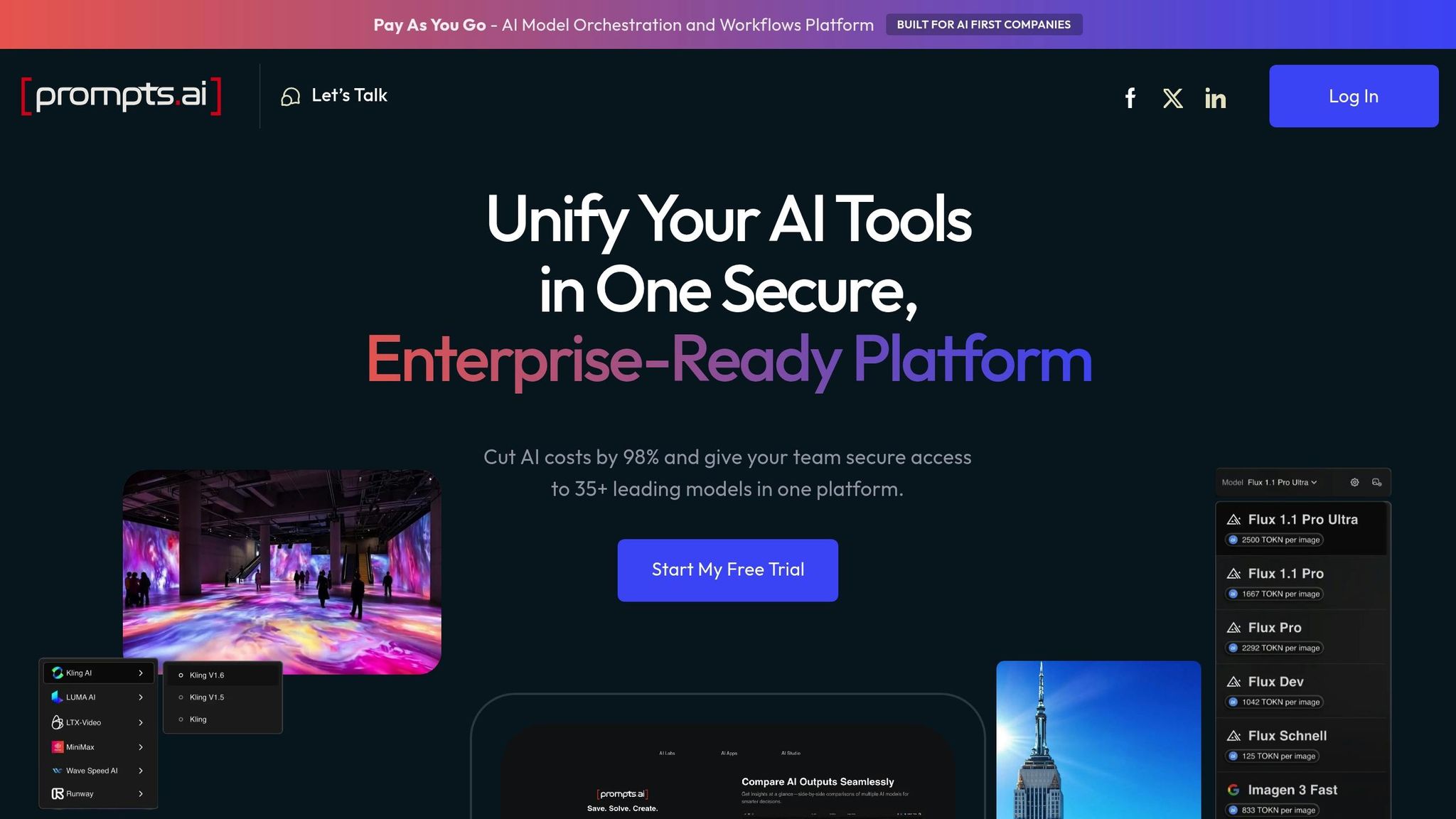
Prompts.ai delivers a powerful solution for managing enterprise AI workflows by combining over 35 top-tier AI models - including GPT-5, Claude, LLaMA, and Gemini - into a single secure platform. It tackles the challenge of managing multiple AI tools while offering the governance, scalability, and cost efficiency that enterprises require.
Prompts.ai is designed to work effortlessly with existing enterprise systems. With support for RESTful APIs, webhooks, and SDKs for Python and JavaScript, the platform makes it easy to connect with data pipelines, CRM platforms, and business intelligence tools. For example, businesses can integrate Salesforce data, process it through custom AI models, and seamlessly push results to Tableau dashboards - all within one environment.
Its modular design ensures compatibility with third-party AI services like OpenAI and Hugging Face, allowing businesses to avoid being locked into a single vendor. This flexibility is particularly useful for companies aiming to streamline AI processes across various departments and systems. Additionally, Prompts.ai supports major cloud providers like AWS, Azure, and Google Cloud, further expanding its integration options.
One insurance company leveraged Prompts.ai to automate claims processing, cutting processing time by 40% while maintaining compliance. These integration features also extend to robust governance tools, which are essential for industries with strict regulations.
Prompts.ai is equipped with governance tools tailored for regulated industries. Features like built-in audit trails, role-based access control (RBAC), and data lineage tracking ensure transparency and accountability in all AI interactions.
"Govern at Scale: Full visibility and auditability across all AI interactions." - Prompts.ai
The platform complies with GDPR, HIPAA, and SOC 2 standards, offering data encryption, consent management, and automated compliance reporting. Prompts.ai initiated its SOC 2 Type 2 audit on June 19, 2025, and uses Vanta for continuous monitoring of controls.
Financial services organizations can configure workflows to automatically redact sensitive data and log every access or modification, simplifying compliance audits. Administrators can also set custom policies to regulate AI model usage, ensuring workflows align with both internal standards and external regulations. Alongside these governance features, the platform is built to scale for enterprise needs.
Prompts.ai’s cloud-native architecture supports auto-scaling and load balancing, enabling it to handle thousands of workflows simultaneously across global operations. It’s designed for organizations with complex infrastructures, allowing orchestration across multiple cloud regions and on-premises setups.
The platform supports unlimited workspaces and collaborators under its Business AI plans, making it ideal for large teams and extensive projects. Users can create as many workflows as needed, ensuring the platform grows alongside organizational demands.
For example, retailers use Prompts.ai to synchronize AI-driven inventory management and customer service workflows across multiple locations. Real-time monitoring ensures resources are managed efficiently and potential issues are addressed proactively.
Prompts.ai offers a usage-based pricing model that aligns with enterprise budgeting strategies. Its FinOps layer tracks every token used, providing detailed cost breakdowns and forecasts to help organizations manage expenses effectively.
The TOKN credit system eliminates recurring fees, allowing businesses to pay only for what they use. Healthcare providers analyzing patient data with Prompts.ai have reported cost savings of up to 98% compared to managing multiple standalone AI tools. The platform’s transparent pricing ensures businesses can optimize their workflows without overspending.
Plans start at $99 per member per month for the Core plan and go up to $129 per member per month for the Elite plan, with custom options available for large-scale deployments. All paid plans include compliance monitoring and governance features, ensuring cost efficiency without sacrificing essential functionality.
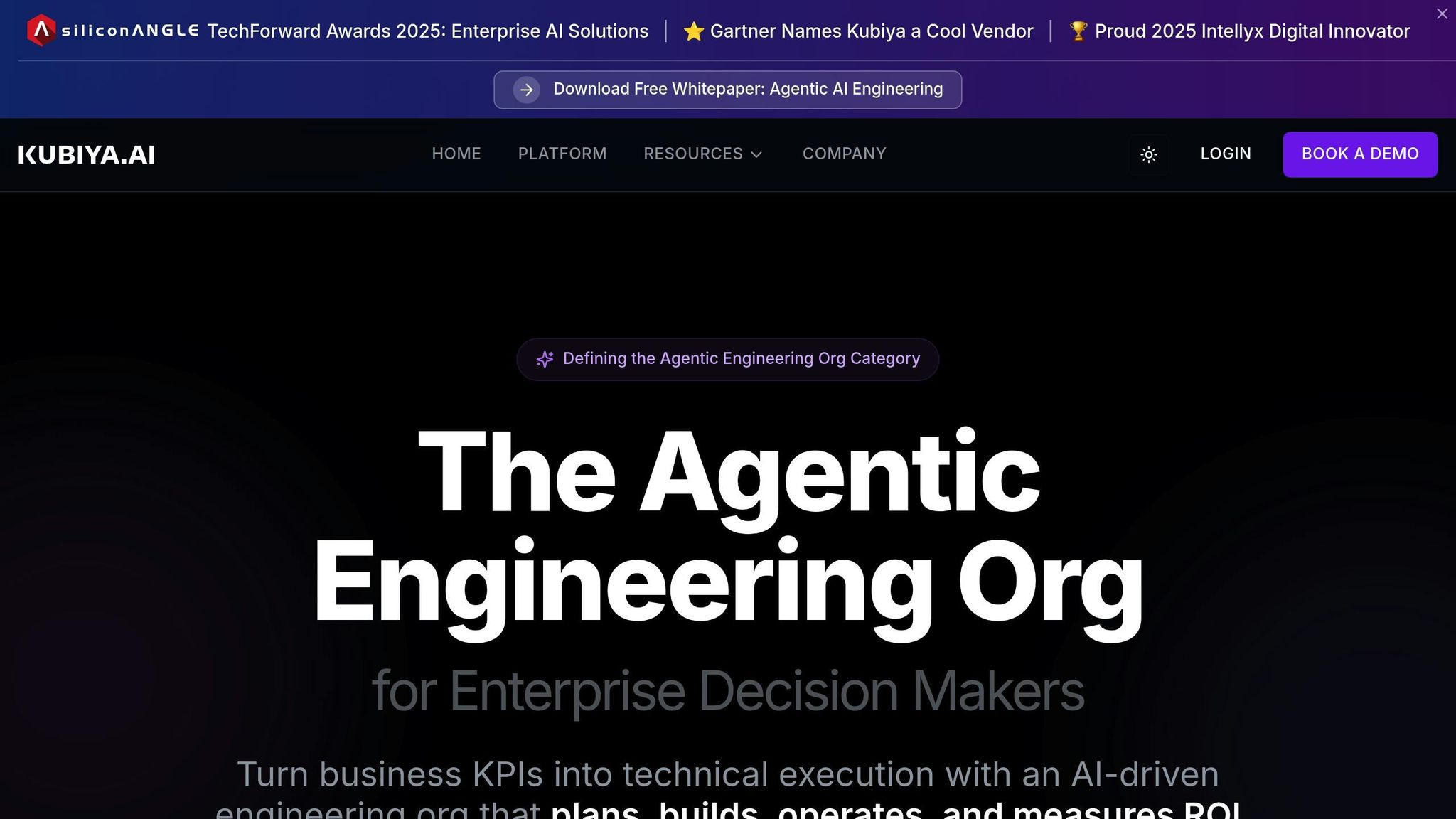
Kubiya AI is built as a multi-agent automation platform, designed to streamline AI workflows and help teams handle intricate processes with coordinated AI agents. By focusing on orchestrating tasks, Kubiya AI simplifies multi-step processes in dynamic settings.
The platform employs a multi-agent system that intelligently distributes tasks among specialized AI agents, each tailored for specific functions like data validation, processing, or decision-making. These agents work together seamlessly, communicating in real time, sharing context, and adapting to changes without the need for manual input. For instance, in managing customer support tickets, one agent might classify the inquiries, another could route them to the right department, and a third might draft initial responses - all happening simultaneously.
What sets Kubiya AI apart is its conversational interface, which allows teams to interact with workflows using natural language commands. This feature lowers the technical barrier, making it accessible even to non-technical team members. Additionally, the platform integrates effortlessly with existing DevOps tools and cloud infrastructure, enabling organizations to incorporate AI automation into their operations without major adjustments.
Kubiya AI’s ability to parallelize tasks, which traditionally required sequential handling, significantly reduces workflow completion times - by as much as 60% in complex enterprise scenarios. Its adaptive learning capabilities further enhance efficiency, as the platform continuously optimizes task allocation based on past performance data.
This coordinated multi-agent approach paves the way for advancements in workflow automation, setting a strong foundation for the next generation of platforms.
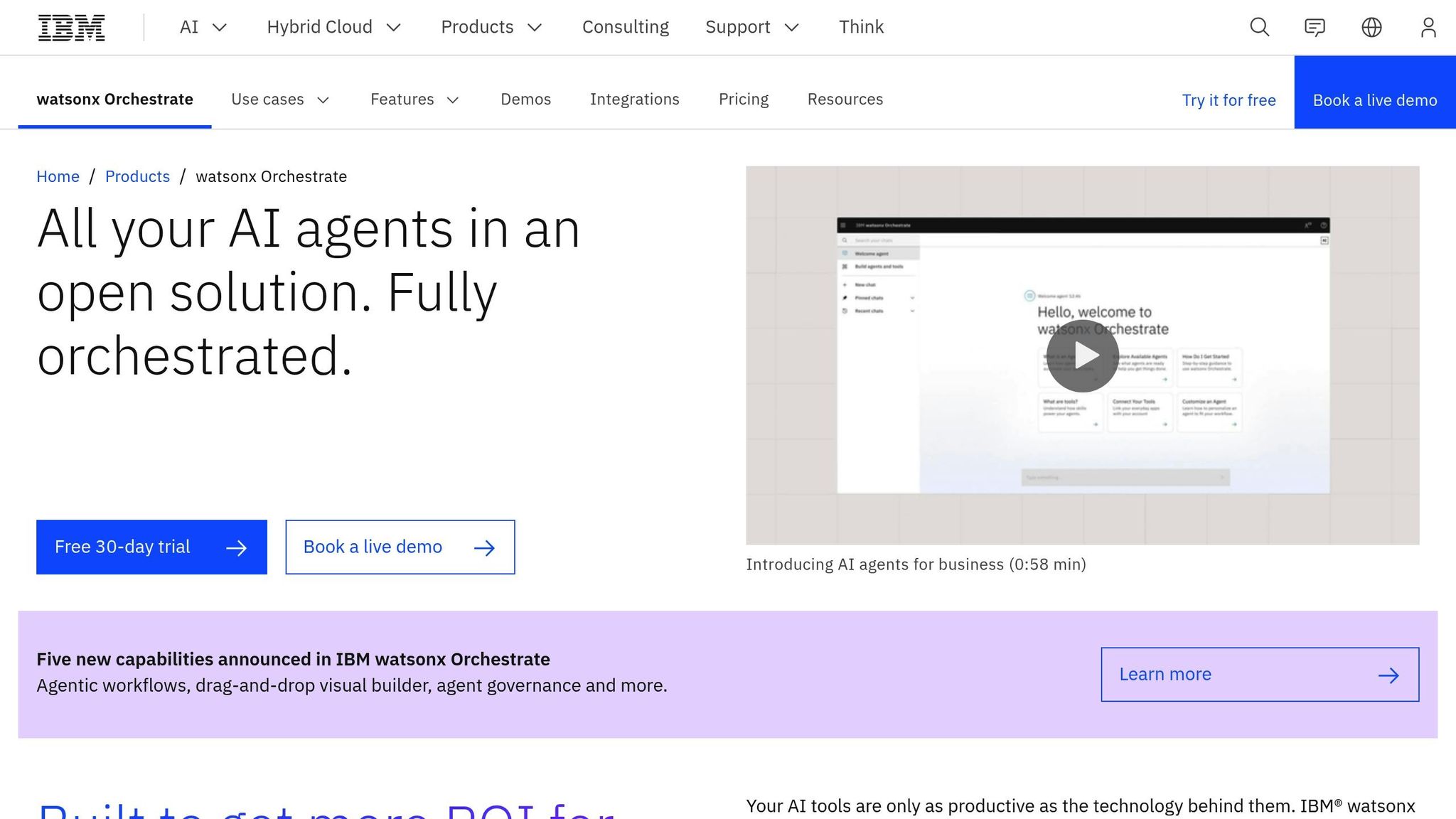
Building on tools like Prompts.ai, IBM watsonx Orchestrate delivers powerful hybrid cloud functionality alongside stringent compliance measures. Designed for enterprises with demanding governance needs, this platform automates complex workflows while ensuring adherence to organizational policies and regulatory requirements. It’s particularly well-suited for industries like financial services and healthcare, where compliance isn’t optional - it’s essential.
Take, for instance, a financial institution that leveraged watsonx Orchestrate to optimize its operations. By automating processes, they significantly reduced processing times and minimized errors. This example highlights the platform’s ability to combine efficiency with robust governance.
IBM watsonx Orchestrate embeds governance into every workflow, ensuring automated processes strictly follow compliance rules. The platform includes detailed audit logs and real-time compliance reporting, enabling organizations to monitor and verify their adherence to security and regulatory standards.
"Integrated governance and compliance guardrails ensure workflows adhere to organizational policies and regulatory requirements."
These built-in safeguards are designed to meet rigorous standards like GDPR, HIPAA, and SOX, making it a reliable choice for highly regulated sectors.
One of the platform’s standout features is its ability to operate seamlessly in hybrid cloud environments. This makes it ideal for enterprises managing diverse IT systems while navigating complex regulatory landscapes. IBM watsonx Orchestrate integrates effortlessly with existing enterprise systems, whether they’re legacy mainframes or modern cloud-based applications, eliminating the need for significant infrastructure overhauls. Additionally, its connection to IBM’s broader AI ecosystem unlocks advanced capabilities, such as machine learning, natural language processing, and predictive analytics, which can be embedded directly into workflows.
Scalability is another key strength of watsonx Orchestrate. Its architecture is designed to grow alongside enterprise needs, accommodating expanding workflows and larger teams with ease. IBM’s deep experience in sectors like financial services and healthcare further reinforces its ability to handle the unique challenges of compliance and scalability effectively.
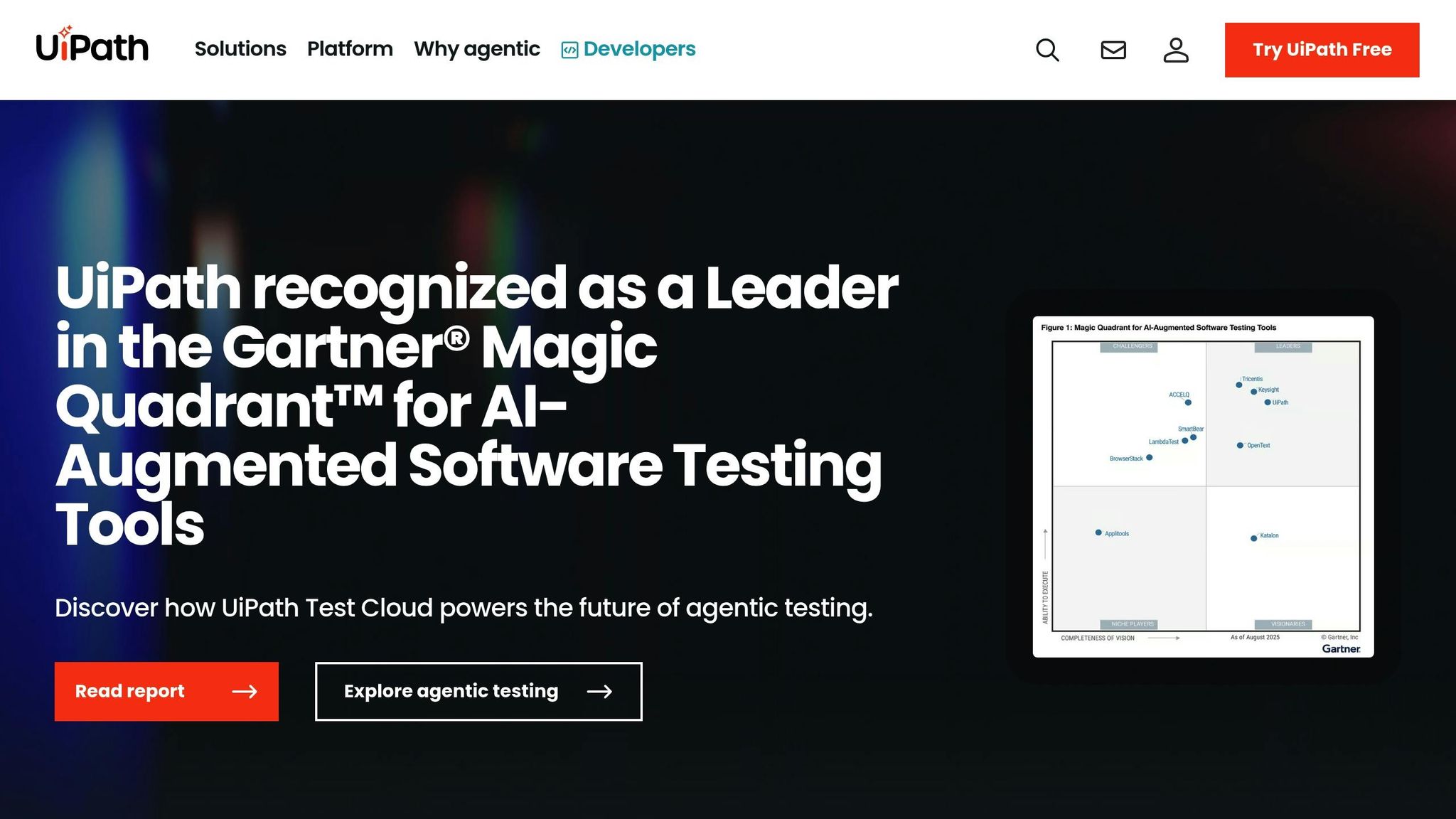
UiPath has transformed from a traditional Robotic Process Automation (RPA) tool into a comprehensive AI orchestration platform. This shift blends structured automation with AI-driven decision-making, creating a system where RPA bots handle routine tasks like data extraction and validation, while AI agents tackle more complex reasoning and decision-making. Together, they form a hybrid model that enhances workflow efficiency and accuracy.
For instance, a global financial services company used UiPath to automate client onboarding, loan processing, and exception handling. This integration slashed claims processing times from 27 days to just 12 hours, showcasing the combined power of RPA and AI.
UiPath Agentic Automation bridges the gap between traditional automation and modern AI systems with ease. It integrates seamlessly with popular AI frameworks and offers a rich library of pre-built automation components. Take loan processing as an example: RPA bots extract and validate customer data, while AI models assess credit risk, detect anomalies, and escalate unusual cases for manual review. This ensures that each tool operates within its area of expertise.
The platform’s architecture is designed to support both legacy systems and modern cloud-based applications, allowing organizations to upgrade workflows without needing to overhaul existing infrastructure.
Governance is a critical feature of UiPath’s platform. Its AI-driven bots are equipped with intelligent validation capabilities to ensure compliance with regulatory standards and organizational policies during process execution. Centralized dashboards provide administrators with real-time insights into all automated activities, while industry-specific solutions address the unique regulatory needs of sectors like banking, healthcare, insurance, and manufacturing.
This robust governance framework not only ensures compliance but also supports scalable adoption across enterprises.
UiPath’s orchestration layer is built to manage extensive bot fleets and handle complex, cross-system workflows. This scalability makes it an enterprise-grade platform capable of meeting the demands of large-scale automation initiatives. By combining the dependability of RPA with the advanced capabilities of AI, UiPath delivers a stable and scalable solution for managing sophisticated enterprise workflows. Its recognition as a leading AI orchestration platform in 2025 further underscores its ability to meet the needs of demanding enterprise environments.
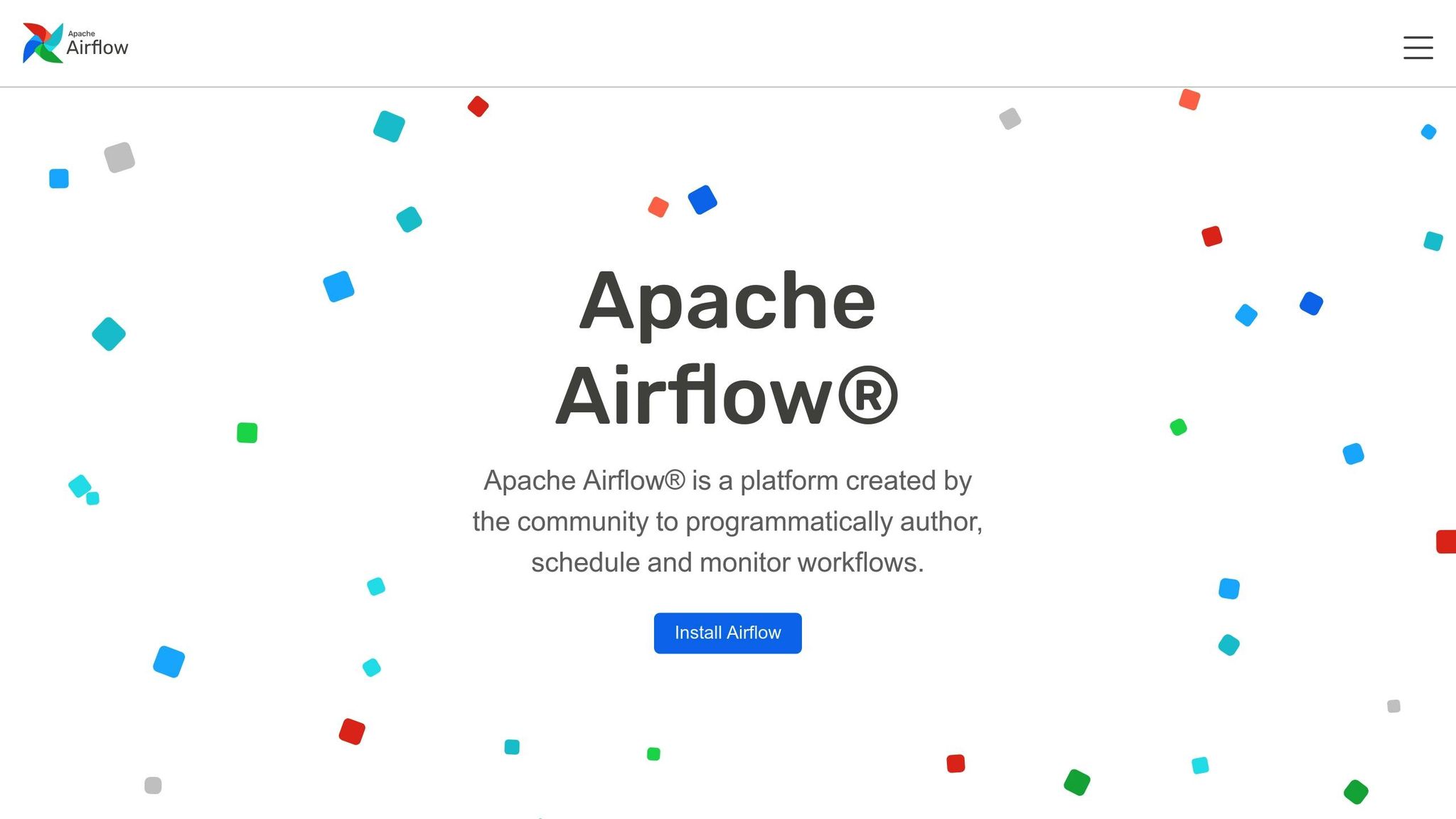
Apache Airflow is a widely-used open-source tool designed for orchestrating and automating intricate workflows. Popular among data engineers and developers, it leverages a Directed Acyclic Graph (DAG) approach to define workflows as Python-based, programmable structures. This design allows teams to dynamically create and adjust pipelines, making it easier to handle evolving workflow needs.
Airflow’s modular architecture makes it highly customizable, thanks to its support for custom operators that enable tailored orchestration. It seamlessly integrates with major cloud platforms like Google Cloud, AWS, and Azure, as well as big data tools such as Apache Hadoop and Apache Spark. Additionally, it works with container orchestration systems like Kubernetes and Docker, alongside databases including Microsoft SQL Server and PostgreSQL.
With its extensive integration options, Airflow is well-suited for handling complex workflows. Its programmable interface simplifies the management of task dependencies, giving developers the ability to design workflows that adapt to changing requirements efficiently.
LangChain is a developer framework designed for building custom AI agents and intricate LLM workflows through graph-based orchestration. It allows developers to set up interconnected nodes, each representing a specific task or agent. This structure offers flexible, non-linear workflow management, making it a strong complement to other platforms for advanced AI applications.
LangChain's modular setup enables seamless connections between LLMs, APIs, and data sources, providing the flexibility needed for complex AI workflows.
LangChain stands out for its ability to integrate with a wide range of tools, thanks to its built-in connectors and abstractions. It supports multiple LLMs, including those from providers like OpenAI and Anthropic, alongside external APIs, databases, and custom data sources. With compatibility across over a dozen major LLM providers and popular data platforms, LangChain makes it easy to chain tasks across different systems. For instance, a workflow could involve one LLM for summarization, another for translation, and an external API for enriching data.
Additionally, LangChain is often used with LangFlow, a visual interface that simplifies workflow design and management. LangFlow enhances usability and speeds up prototyping, making it easier for developers to create and refine their workflows.
LangChain supports distributed execution and integrates with cloud platforms like Kubernetes, enabling workflows to run in parallel and manage resources dynamically across nodes or regions. Its popularity is evident from its strong community presence, including thousands of GitHub stars. This growing interest highlights the appeal of graph-based orchestration for developing custom agents and coordinating multiple AI tasks.
As an open-source framework, LangChain is free to use, with no licensing fees. However, enterprises need to consider costs related to cloud infrastructure, compute resources, and third-party APIs, which may include charges for tokens or requests. While LangChain itself doesn’t have an official pricing model, commercial support is available through third-party vendors. This framework is well-suited for teams with the technical expertise to create scalable and tailored AI workflow solutions.
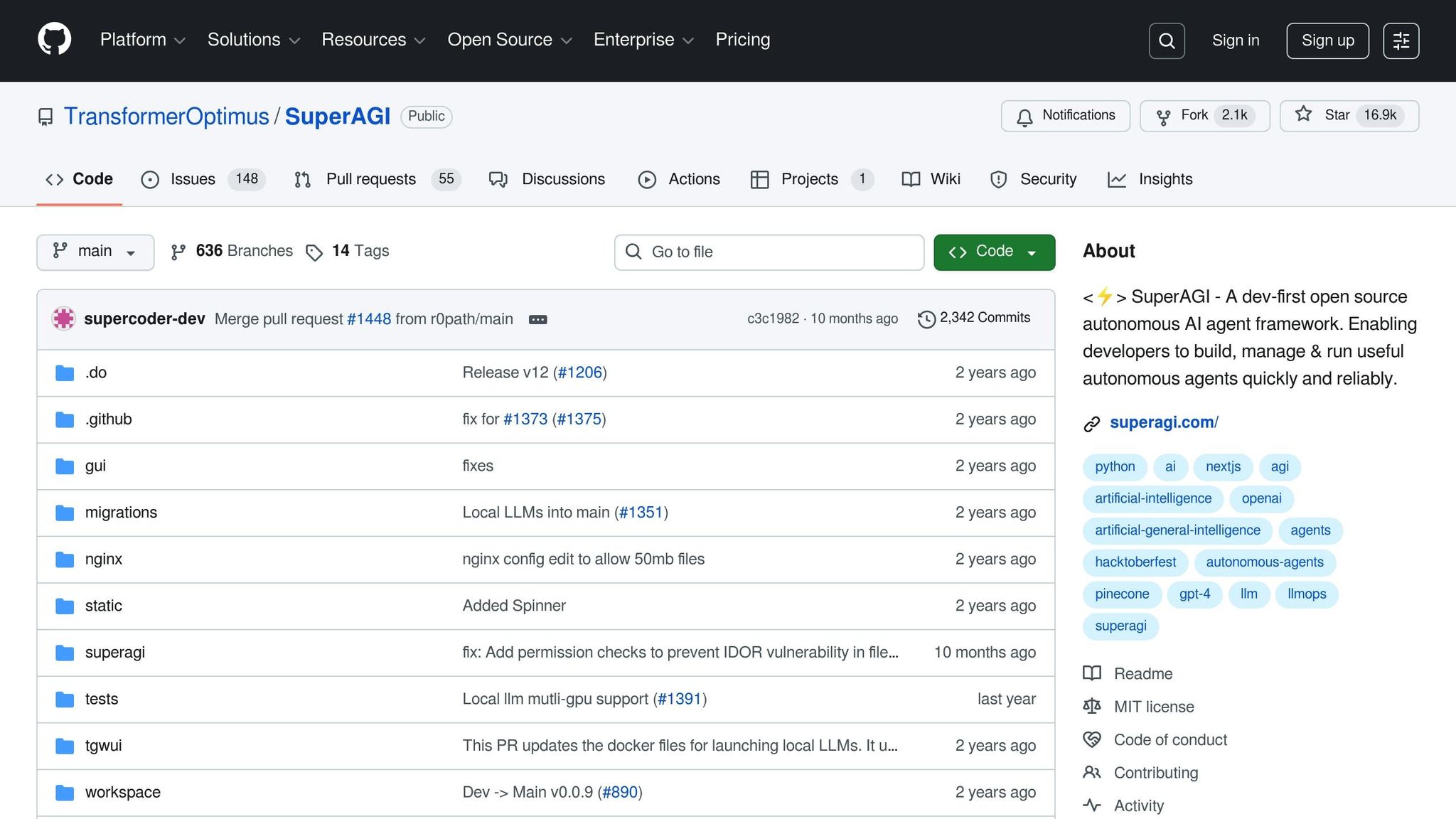
SuperAGI is a powerful platform designed to manage and deploy autonomous AI agents on a large scale. It specializes in coordinating workflows among fully autonomous agents, handling advanced task delegation, and providing robust monitoring capabilities. This makes it particularly useful for software engineers looking to streamline and automate intricate processes.
SuperAGI’s multi-agent system is tailored to meet the demands of enterprise operations. It enables businesses to automate tasks and make AI-driven decisions efficiently, even under heavy workloads. Its ability to handle operations at scale ensures seamless management of complex workflows.
As an open-source platform, SuperAGI eliminates the need for costly licensing fees. Organizations only need to budget for infrastructure, computing resources, and maintenance, making it a cost-effective choice. Its open-source nature also allows businesses to start small, test its capabilities, and expand usage as needed - minimizing financial risks. This blend of scalability and affordability makes SuperAGI a compelling option for enterprises seeking AI workflow solutions.
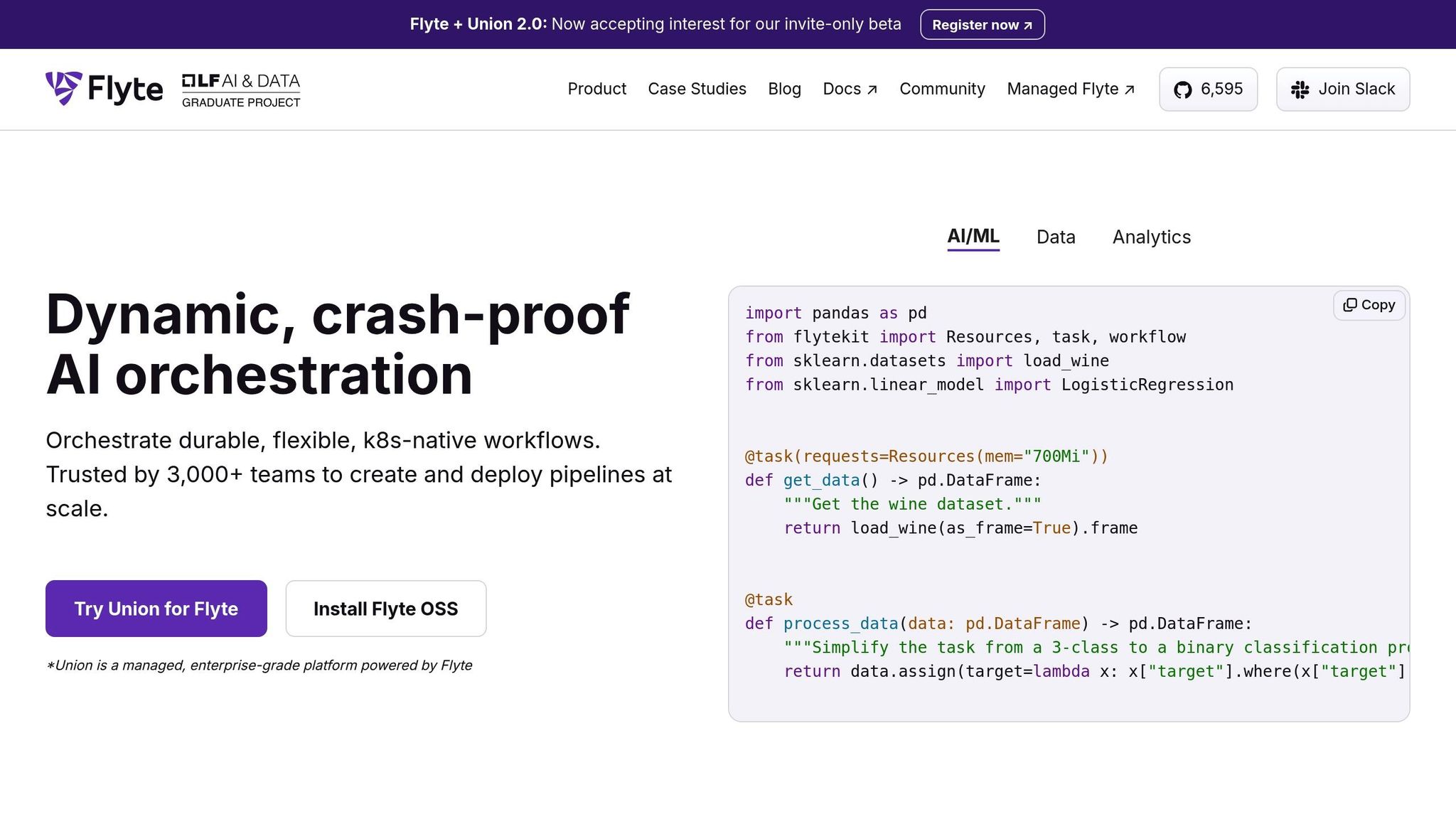
Flyte is a cloud-based orchestration platform designed to streamline enterprise ML workflows. Built to work seamlessly with Kubernetes, Flyte enables the deployment of reproducible, containerized ML pipelines across development, staging, and production environments. By packaging each workflow component into containers, Flyte ensures consistency across environments, solving the common "it works on my machine" problem. This approach promotes smooth integration and efficient resource use throughout ML processes.
Flyte's Kubernetes-native design allows it to integrate effortlessly with existing AI and ML tools. Since the platform runs containerized workflows, any tool that can be packaged into a Docker container fits seamlessly into its system. Flyte also offers a robust plugin ecosystem, which simplifies the process of building and deploying workflows. These plugins connect with widely used data science tools, cloud services, and infrastructure, making it easier for teams to manage their ML operations.
Flyte brings enterprise-level scalability to ML operations through Kubernetes' resource management capabilities. The platform automates the orchestration of containers, adjusting workflows dynamically to meet computational needs and available resources. Its distributed architecture enables the execution of large-scale ML pipelines across multiple nodes and clusters. This makes it possible for organizations to handle massive datasets and run complex model training workflows without being limited by infrastructure.
Flyte optimizes costs by managing ML infrastructure more effectively. Using Kubernetes' resource allocation features, Flyte ensures computing power is allocated based on actual workflow requirements rather than maintaining constant overprovisioned systems. This dynamic approach reduces resource waste, allowing teams to use only the computing power they need, when they need it.
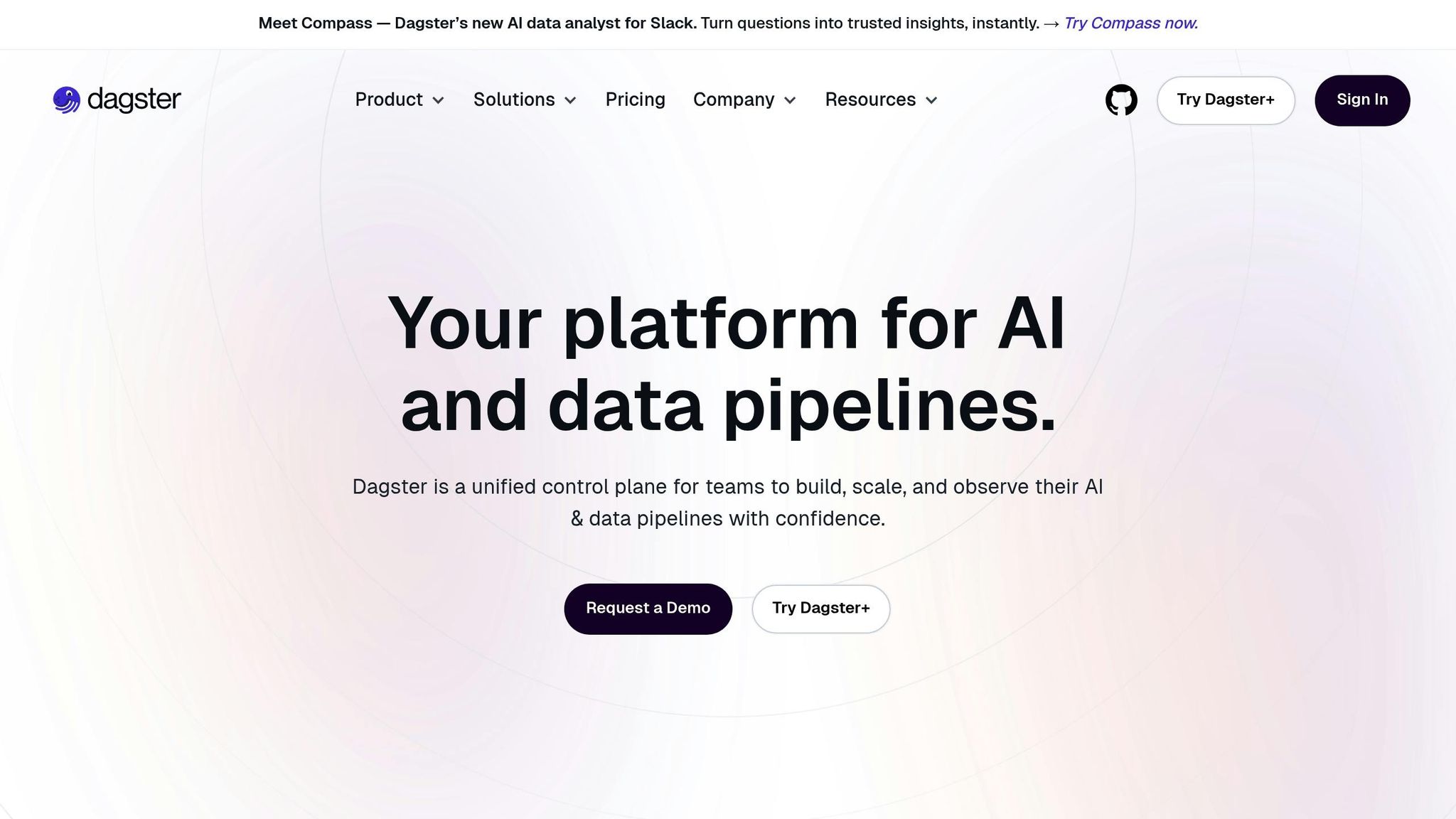
Dagster is an open-source platform designed to orchestrate workflows for machine learning, analytics, and ETL processes. Built around code, it seamlessly supports frameworks like Spark, SQL, and DBT, making it a versatile choice for managing complex operations across various technologies.
Dagster brings together diverse AI and data tools under one orchestration framework, streamlining the creation of end-to-end AI pipelines. By integrating ETL and ML processes, it bridges the gap between data engineering and machine learning teams. Its deployment is highly adaptable, supporting everything from local development setups to production Kubernetes clusters. A unified tracking interface allows teams to monitor pipelines, database tables, and ML models, breaking down operational silos. Additionally, Dagster incorporates data version control through programmatic API calls, enabling teams to handle data commits, branching, and merging directly within their workflows. This ensures a smooth transition from raw data to actionable insights.
Dagster emphasizes data quality and workflow reliability with built-in validation tools that uphold data integrity throughout ML pipelines. Its observability features provide detailed monitoring and audit trails, making troubleshooting easier and ensuring adherence to regulations. The platform's repository-based architecture further enhances stability by isolating codebases, which is critical for maintaining compliance. This governance structure supports the scaling of intricate data operations.
Dagster's asset-focused approach naturally accommodates the growth of organizational data sources, ML models, and analytics. Its unified view of pipelines, tables, and models ensures teams retain clarity as operations become more complex. The platform’s deployment flexibility allows teams to start small in local environments and expand to Kubernetes-based setups as workflows demand greater resources.
As an open-source solution, Dagster eliminates licensing fees while offering enterprise-level orchestration capabilities. Its efficient reprocessing feature enables workflows to restart from checkpoints, conserving both compute time and resources. By integrating data versioning, Dagster minimizes the risk of partial failures, reducing the need for costly rollbacks or reruns. This combination of features ensures cost-effective and reliable workflow management.

Prefect is a platform designed for automating dataflows and managing dynamic machine learning workflows in a cloud-native environment.
Prefect is built to adapt to various deployment needs, offering hybrid execution across both cloud and on-premises setups. It integrates seamlessly with leading cloud providers like AWS, Google Cloud Platform, and Microsoft Azure. Additionally, it works natively with container technologies such as Docker and Kubernetes and supports distributed computing frameworks like Dask and Apache Spark.
With a fault-tolerant engine and tools for real-time observability, Prefect ensures workflows remain stable and efficient at scale.
Prefect’s cloud-native design and advanced scheduling tools make it well-suited for managing multiple workflows simultaneously. It’s particularly effective in handling the complexities of dynamic machine learning processes in enterprise settings.
Here’s a streamlined comparison highlighting the core features of each platform. This table provides a quick reference to evaluate interoperability, deployment options, governance, scalability, and pricing.
| Platform | Interoperability | Deployment Options | Governance Features | Scalability | Pricing (USD) |
|---|---|---|---|---|---|
| Prompts.ai | Supports 35+ LLMs (GPT-5, Claude, LLaMA, Gemini) via a unified API | Cloud-native with enterprise-grade security | Audit trails, compliance controls, real-time FinOps | Enterprise-level scalability with 10x productivity boost | Pay-as-you-go TOKN credits, starting at $29/month |
| Kubiya AI | Integrates with cloud providers, DevOps tools, and collaboration platforms | Cloud-native with secure on-premises connectors | RBAC, SSO, audit trails, policy enforcement | Scales multi-agent automation | Tiered, usage-based pricing with custom enterprise quotes |
| IBM watsonx Orchestrate | Deep integration with IBM AI ecosystem, hybrid cloud support | Cloud, on-premises, and hybrid options | Governance frameworks, compliance guardrails, audit logs | Distributed workflows for large enterprises | Subscription-based, enterprise plans starting at thousands/month |
| UiPath Agentic Automation | Connects to enterprise systems, RPA, and AI agent orchestration | Cloud and on-premises deployment | Advanced access controls, compliance reporting | Handles complex workflows at scale | Subscription-based, custom enterprise pricing |
| Apache Airflow | Plugin support for data sources, ML frameworks, and cloud services | Open-source: on-premises, cloud, or hybrid via Kubernetes | Audit logging, integration with external governance tools | Distributed execution with high availability | Free open-source, managed services range from $100s to $1,000s/month |
| LangChain | Graph-based AI process integration and multi-agent frameworks | Flexible deployment across environments | Basic audit features, additional configuration required | Supports autonomous multi-agent orchestration | Open-source free, enterprise support varies |
| SuperAGI | Multi-agent workflows and autonomous agent integration | Cloud-native with distributed deployment | Basic audit capabilities, requires configuration | Scalable multi-agent orchestration | Usage-based pricing with enterprise tiers available |
| Flyte | Kubernetes-native ML workflows, integrates with cloud APIs | Kubernetes-native: cloud, on-premises, or hybrid | Audit trails, version control; external governance tools needed | Scalable distributed ML workflows | Free open-source, managed services range from $100s to $1,000s/month |
| Dagster | Data-centric workflow connectors with cloud-native integrations | Open-source: cloud, on-premises, or hybrid | Audit logging, data lineage, and external governance integration | Cloud-native scalability with dynamic scheduling | Free open-source, Dagster Cloud starts at $100s/month |
| Prefect | Integrates with AWS, GCP, Azure, Docker, Kubernetes, Dask, and Spark | Hybrid execution across cloud and on-premises | Real-time observability, fault-tolerant engine | Manages dynamic ML workflows simultaneously | Free open-source, Prefect Cloud ranges from $100s to $1,000s/month |
For technically skilled teams, open-source platforms provide substantial cost savings, while enterprise-focused solutions offer robust support and features at higher price points.
Most platforms support hybrid deployment models. IBM watsonx Orchestrate and UiPath stand out for their enterprise-grade deployment options, while Kubernetes-native solutions like Flyte excel in cloud-native environments.
Platforms such as Prompts.ai, Kubiya AI, IBM watsonx Orchestrate, and UiPath lead in governance capabilities with built-in audit trails, compliance controls, and policy enforcement. Open-source options typically require additional setup and third-party tools to reach enterprise governance standards.
This overview highlights the strengths of each solution, helping you identify which platform aligns best with your operational and technical requirements.
Selecting the right AI workflow platform is key to avoiding tool overload and achieving automation efficiency. The platforms discussed here are built on three essential pillars: strong governance, clear cost management, and integrated functionality.
For U.S. enterprises navigating a complex AI environment, governance is non-negotiable. Platforms like Prompts.ai offer detailed audit trails, while IBM watsonx Orchestrate and UiPath provide the oversight critical for industries with strict regulatory demands. Alongside governance, managing costs transparently is just as important.
Although open-source options like Apache Airflow and Dagster may appear appealing, they often require additional integration efforts. On the other hand, enterprise platforms such as Prompts.ai deliver predictable and scalable pricing with a straightforward pay-as-you-go model, starting at $29 per month.
A unified platform simplifies operations by consolidating functions into a single interface. This reduces the complexity of integrations, minimizes training requirements, addresses security risks, and speeds up the time it takes to see results.
When deciding on a platform, technical teams should consider compatibility with their existing infrastructure. Kubernetes-native solutions like Flyte are ideal for cloud-based setups, while IBM and UiPath cater to hybrid environments. Ultimately, the decision should strike a balance between immediate technical priorities and long-term goals for scalability and governance.
As the AI workflow orchestration market grows, organizations that prioritize governance, cost control, and integrated operations will be better equipped to seize future opportunities while maintaining efficiency and compliance.
When choosing an AI workflow orchestration platform, it's important to consider elements that promote both efficiency and growth. Aim for a platform with user-friendly tools that make it easy for teams to get started, adaptable features to accommodate changing needs, and smooth integration with your current systems.
It's also wise to focus on platforms offering strong data analytics and reporting tools, enabling you to turn insights into action. Look for solutions that encourage collaboration between AI and human teams, ensuring streamlined processes while maintaining the essential human perspective.
Open-source tools like Apache Airflow are often appealing for their lower upfront costs since they are free to use and can be self-hosted. These tools also allow for a high degree of flexibility, enabling users to tailor configurations to meet their unique requirements.
On the other hand, enterprise platforms tend to involve higher expenses due to licensing fees. Despite the cost, they deliver enhanced features, dedicated customer support, and simplified setup processes, making them a strong choice for organizations that prioritize scalability and all-in-one service solutions.
Prompts.ai incorporates strong governance features to address the demanding standards of regulated industries. By adhering to established frameworks such as SOC 2 Type II, HIPAA, and GDPR, it ensures top-tier data security and compliance.
To further enhance protection, Prompts.ai utilizes continuous control monitoring through partnerships with trusted platforms like Vanta. This collaboration adds an extra layer of confidence in maintaining compliance and securing sensitive data.


